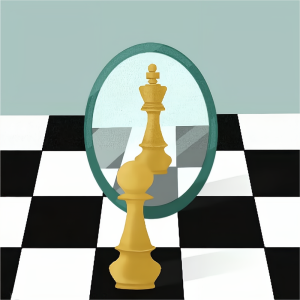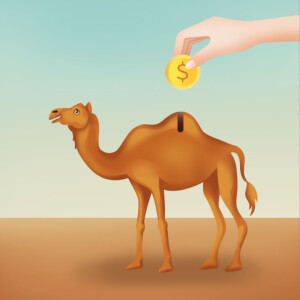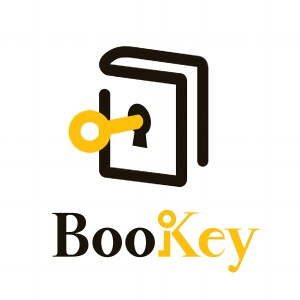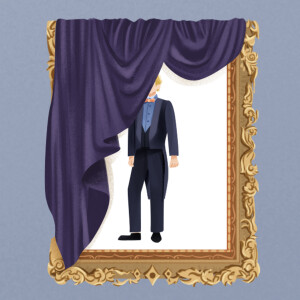Episodes

Thursday Apr 06, 2023
Thursday Apr 06, 2023
The Art of Seduction
The Art of Seduction Full Chapter Book Summary
The Art of Seduction (2001) is the second book by Robert Greene. As an international bestseller, the book offers a comprehensive and complex understanding of the art of seduction, providing readers with the knowledge to understand the intricate dynamics of successful seduction.
Overview | Chapter 1
Hi, welcome to Bookey. Today we will unlock the book The Art of Seduction.
Are you tired of being overlooked and ignored? Do you want to become the master of seduction and have others falling at your feet? Look no further than The Art of Seduction by Robert Greene.
Once upon a time, there was a beautiful princess in a faraway kingdom. Every day, she would take a stroll in the woods near her castle, marveling at the beauty of nature. One day, she was surprised by a mysterious man with a charming smile. He was a master of the art of seduction. Through clever words and subtle gestures, he captivated the princess with his seemingly effortless ability to make her feel special and desired.
Such art of seduction has been around for centuries, as it is one of the most powerful tools for expressing attraction and building deep connections. It is both an art and a science, requiring a mastery of psychology, body language, and communication.
The book The Art of Seduction, written by bestselling author Robert Greene is a comprehensive guide to mastering the art of seduction and achieving success in relationships and persuasion.
First, you may ask, who is Robert Greene? Robert Greene is an internationally bestselling author best known for his books The 48 Laws of Power, The 33 Strategies of War and The Art of Seduction. He has written several other books on the power of influence, personal development and strategy. He has a unique writing style, combining a mix of historical anecdotes, psychological understanding, and practical advice. Greene has been featured in The New York Times and The Wall Street Journal and has been featured in several documentaries. He continues to be a sought-after speaker at seminars and universities around the world.
Now, let’s get back to the book. The book mainly explores the concept of seduction and its significance in human relationships. Through a series of case studies and historical examples, Greene delves into the psychology and strategies of seduction, offering practical advice and insights for readers who wish to improve their skills in this area.
One of the key concepts explored in the book is the idea that seduction is not just about sexual attraction, but also about the ability to influence and persuade others. This is a crucial skill in today's world, where competition and persuasion are often necessary to succeed in personal and professional relationships.
The significance of seduction in human relationships cannot be overstated. Whether in the pursuit of personal or professional goals, the ability to seduce and persuade others is essential for achieving success and fulfillment. The Art of Seduction is a must-read for anyone looking to master the art of seduction.
Next, we will talk about this book in four parts, from which you will learn valuable insights and practical advice on the mastery of seduction.
In Part One, we will introduce nine types of seducers and the characteristics of their victims.
In Part Two, we will discuss the three principles and four stages of seduction.
In Part Three, we will explore the key tips and techniques that guide you to seduce others.
In Part Four, we will talk about the rewards and risks of seduction.

Wednesday Mar 29, 2023
Wednesday Mar 29, 2023
Réfléchissez et devenez riche
Résumé du livre de Réfléchissez et devenez riche
Pensez et grandissez Rich nous enseigne que pour des millions de personnes, le désir peut être le moteur du succès. Toute personne intéressée à suivre ce chemin vers le succès doit prendre quelques étapes simples. Pour commencer, bien sûr, nous devons avoir un fort désir. Avec cette aspiration, nous pouvons affecter le subconscient à travers l'autosuggestion. L'esprit subconscient renforce notre foi et notre confiance. Il plante une graine. Avec le temps, il germe et un plan survient. Ce qui suit est l'action sans aucun doute. La méthode exploite pleinement le subconscient. Il devient un "intermédiaire" qui transforme les désirs en effets tangibles. Grâce à ce processus, vous vous rendrez compte que le simple fait de penser de la bonne manière peut vous rendre riche.
Overview | Chapter 1
Bonjour, bienvenue sur Bookey. Aujourd'hui, nous allons débloquer le livre Think and Devenir riche. Un jour, dans les premières années du 20e siècle, à Orange, dans le New Jersey, aux États-Unis, un visiteur est entré dans le bureau de Thomas A. Edison. L'invité ressemblait un peu à un sans-abri épuisé après un long et pénible voyage. Il s'est présenté comme Edwin C. Barnes. Il a exprimé son souhait de longue date d'être le partenaire commercial d'Edison. Edison a rappelé plus tard que quelque chose sur le visage de Barnes avait transformé la détermination. C'était quelqu'un qui n'abandonnerait pas avant d'avoir atteint son objectif. Grâce à son expérience des relations humaines, Edison avait appris que lorsque le désir d'une personne était si fort qu'elle était prête à miser tout son avenir sur sa réussite, elle ne pouvait que réussir. Edison a permis à Barnes de rester, mais seulement en tant que péon et non en tant que partenaire commercial. Néanmoins, Barnes ne pensait pas que son travail n'était pas qualifié; Au lieu de cela, il s'est tenu à des normes élevées. Et quelques années plus tard, il a finalement obtenu son souhait. Il est devenu le véritable partenaire commercial d'Edison et s'est retrouvé à travailler dans la même pièce dans laquelle il avait fait une erreur lorsqu'il a rencontré Edison pour la première fois. C'est l'histoire au début de Think and Deveil Rich. L'anecdote nous dit que le succès d'une personne est fonction de son désir. Plus leur désir est intense, plus leur succès. Quelle était la force de la passion de Barnes pour le succès? Lorsqu'il était déterminé à devenir le partenaire commercial d'Edison, il ne connaissait pas ce célèbre scientifique et n'avait pas non plus l'argent nécessaire pour se rendre dans la ville où il travaillait. Face à ces deux difficultés, la plupart des gens ont peut-être déjà abandonné leurs plans. Mais pas Barnes. Son désir était si fort qu'il a grimpé dans un train de marchandises pour atteindre la destination et s'est finalement tenu devant Edison. Lorsque vous renforcez la détermination, vous pouvez surmonter tous les obstacles apparemment insurmontables. Think and Grow Rich est un livre sur une pensée efficace. Il pourrait être décrit comme un livre sur la passion du succès. Dans le titre, le mot "riche" a plusieurs connotations. Au-delà de la richesse et du succès financier, ces richesses incluent également des domaines spirituels, mentaux et corporels. Depuis sa publication pour la première fois en 1937, le livre s'est vendu à plus de 70 millions d'exemplaires dans le monde et a influencé les chemins d'innombrables vies. L'auteur du livre, Napoleon Hill, était un expert en motivation pionnier cherchant à identifier les principes du succès. Alors que la première édition de l'ouvrage est maintenant datée, elle a été éditée et révisée en 2004 par Arthur R. Pell, qui a un doctorat. en philosophie. Il a remplacé quelques histoires et anecdotes obsolètes par des exemples plus contemporains. Le livre, dans sa version mis à jour, est désormais largement disponible et reste durable. Comme Hill le dit, le «King Steel», Andrew Carnegie, a été formatif dans la genèse du livre. Carnegie avait demandé à Hill, un journaliste à l'époque, d'identifier et d'interviewer 500 personnes qui réussissent dans le but de découvrir leurs traits communs et, finalement, de partager ce précieux secret du succès avec le monde. Hill était ravi d'accepter la tâche et, finalement, il a interviewé plus de 500 personnes, y compris des personnalités importantes telles que Edison, Ford et Roosevelt. De plus, il a étudié et analysé les histoires de vie de 25 000 personnes qui réussissent pour éventuellement isoler la recette du succès qui, selon Carnegie, devait exister. Dans l'esprit, il a écrit ce livre, vous invitant à penser et à devenir riche. Ensuite, nous vous révélerons les meilleures parties du livre. Nous l'avons divisé en deux sections: Première partie, le chemin du succès guidé par le désir; Deuxième partie, protégeant le chemin du succès fondé sur le désir.

Wednesday Mar 29, 2023
Wednesday Mar 29, 2023
Le Loup de Wall Street
Résumé du livre de Le Loup de Wall Street
Ce livre est le mémoire d’un homme qui était autrefois connu comme « le loup de Wall Street ». À un moment donné, Jordan Belfort a gagné la somme colossale de 12 millions de dollars en seulement trois minutes. Le magazine Forbes l’a qualifié de « version tordue de Robin des Bois » sur le marché boursier. Il a ensuite été condamné à la prison pour avoir escroqué environ 200 millions de dollars à des investisseurs. À travers les révélations de Belfort sur la trajectoire de sa vie, nous avons un aperçu du monde éblouissant du pouvoir, de la cupidité et de l’excès.
Introduction | Chapitre 1
C’était en 1998 dans une maison luxueuse sur la côte de Long Island. Une odeur de fumée de cigarette et d’alcool flottait dans l’air. Des jeunes hommes et des jeunes femmes dansaient comme s’il n’y avait pas de lendemain. C’était une fête somptueuse. Soudain, les gens ont entendu le retentissement d’une sirène. Des policiers sont entrés dans la maison, se sont dirigés directement vers Jordan Belfort et lui ont passé les menottes. Belfort était autrefois un courtier en bourse important de Wall Street, tristement connu comme ce que Forbes a appelé la « version tordue de Robin des Bois », et « le loup de Wall Street » dans le monde des affaires de Wall Street. Né et élevé dans une famille ordinaire, Belfort n’a pas de formation universitaire en finance. Cependant, il a réussi à s’imposer dans le monde de la finance en très peu de temps. Grâce à des stratagèmes méprisables, il a pu gagner 12 millions de dollars sans effort en seulement trois minutes. À l’âge de 31 ans, Belfort était déjà multimillionnaire. Mais à 36 ans, il a été arrêté pour fraude fédérale. Comment Belfort a-t-il pu accomplir cette accumulation spectaculaire de capital en si peu de temps ? Et comment a-t-il fini en prison, pour ensuite se racheter et même voir l’histoire de sa vie projetée sur grand écran ?
Le Loup de Wall Street est plus qu’une simple autobiographie. Il s’agit plutôt d’une histoire intrigante de transformation de l’état d’esprit. Belfort a été encouragé par un codétenu à écrire ce livre en prison. Alors qu’il était en prison en train de réfléchir à son passé, le monde extérieur était encore perturbé par ce qu’il avait fait. Plusieurs éditeurs se sont battus pour obtenir les droits de publication de son livre. Plus tard, Hollywood a manifesté son intérêt pour faire de ce livre un film. Il a été rapporté que Brad Pitt et Leonardo DiCaprio étaient en compétition pour jouer le rôle de Belfort dans le film du même nom. Leonardo DiCaprio a finalement obtenu le rôle, et le film est devenu une superproduction, rapportant plusieurs centaines de millions de dollars. Il a été nommé pour plusieurs prix, dont l’Oscar du meilleur film, et a également été sélectionné comme l’un des dix meilleurs films de l’année lors de la 14e édition des AFI Awards.
Qu’est-ce qui fait la différence entre un magnat de la finance et un investisseur moyen ? Sont-ils nés riches et tenaces ? Ont-ils toujours du succès et n’échouent-ils jamais ? Nous découvrirons les réponses à ces questions en suivant les pas de Belfort, une figure légendaire de Wall Street dont la vie était autrefois marquée par la cupidité, le sexe et la drogue. Nous allons découvrir ce livre dans les quatre parties suivantes.

Wednesday Mar 29, 2023
Wednesday Mar 29, 2023
Warren Buffett
Résumé du livre de Warren Buffett
« La boule de neige se produit simplement si vous êtes dans le bon type de neige, et c’est ce qui m’est arrivé. Je ne parle pas seulement de l’argent capitalisé. C’est en termes de compréhension du monde et du type d’amis que vous accumulez. » C’est la philosophie de la boule de neige de Warren Buffett. Il était autrefois l’homme le plus riche du monde, ayant gagné son énorme richesse en investissant. Beaucoup se sont demandés comment Buffett a fait. Quelles sont ses philosophies pour faire des affaires ? Ce livre vous donnerez les réponses.
Introduction | Chapitre 1
Bonjour, bienvenue sur Bookey. Aujourd’hui, nous allons parler du livre Warren Buffett. La Biographie Officielle, L’effet Boule De Neige.
Vous avez sûrement déjà entendu le nom de Warren Buffett. Connu sous le nom de « Oracle d’Omaha », il est l’un des chefs d’entreprise les plus riches et les plus respectés au monde et un gourou de l’investissement. Fin 2007, sous la direction de Buffett, Berkshire Hathaway avait un cours de bourse de plus de 140 000 dollars par action et une capitalisation boursière impressionnante de plus de 200 milliards de dollars. En décembre 2017, la capitalisation boursière de l’entreprise a atteint le chiffre stupéfiant de 480 milliards de dollars. Buffett est également l’un des philanthropes les plus généreux du monde. En juin 2006, Buffett a annoncé qu’au cours des années suivantes, il ferait don de 85 % des actions de Berkshire Hathaway à des fondations caritatives, ce qui représentait un total de 37 milliards de dollars à l’époque. Un don aussi important a fait sensation.
Comme le livre s’intitule « La boule de neige », vous vous demandez peut-être à quoi fait référence « la boule de neige ». Au tout début du livre, l’auteur dépeint une scène d’un Buffett de 9 ans jouant dans la neige. Il est avec sa petite sœur dans son jardin. Il tasse la neige en une petite boule qu’il fait lentement rouler sur le sol. Chaque fois qu’il la pousse, la boule ramasse plus de neige. Ainsi, la boule de neige devient de plus en plus grosse. À partir de là, Buffet a continué à avancer, jetant son regard sur un monde entier rempli de neige. Comme il le dit, « La vie est comme une boule de neige, tout ce dont vous avez besoin, c’est de neige mouillée et d’une très longue colline ». Et cela ne s’applique pas seulement à l’accumulation d’argent ; cela fait aussi référence à la compréhension du monde et au genre d’amis que vous accumulez.
L’auteur de ce livre, Alice Schroeder, est une ancienne directrice conseillère chez Morgan Stanley, l’une des banques d’investissement les plus réputées au monde. Elle a fait la connaissance de Buffett alors qu’elle rédigeait un rapport d’analyse sur Berkshire Hathaway et est devenue la première et la seule analyste financière à pouvoir interviewer Buffet. Buffett a apprécié sa perspicacité et sa capacité à maîtriser un sujet, il l’a donc autorisée à écrire sa biographie.
Pour écrire ce livre, elle a passé cinq ans à interviewer Buffett pour un total de plus de 2 000 heures. Elle a également interviewé 250 autres personnes, dont ses amis, sa famille et ses collègues de travail. Elle a eu accès à de nombreuses lettres et dossiers personnels de Buffett jamais publiés auparavant. Contrairement aux livres précédents qui mettent trop l’accent sur le succès et l’expérience de vie légendaire de Buffett, ce livre raconte non seulement ses histoires légendaires d’investisseur de premier ordre, mais dépeint aussi son côté humain. Ainsi, il nous est permis de connaître véritablement les expériences les plus précieuses de Buffett tout au long de ses plus de 60 ans d’activité et d’investissement. Si vous vous intéressez à Buffett et à sa vie de riche, L’effet Boule De Neige est une excellente lecture. Et si vous voulez en savoir plus sur sa philosophie d’investissement, vous pouvez trouver les livres sur The Warren Buffett Way et The Little Book That Builds Wealth.

Wednesday Mar 29, 2023
Wednesday Mar 29, 2023
L'Étranger
Résumé du livre de L'Étranger
L'Étrangerest un roman d'événements fortuits. Meursault est impliqué, malgré lui, dans le conflit qui opposel'un de ses amis à un Arabe et tue ce dernier sans le vouloir. Au cours du procès, on l'interroge davantage sur son comportement lors de l'enterrement de sa mère que sur le meurtre. Comme Meursault n'a pas pleuré pendant les funérailles de sa mère, le juryen déduit que c'est un homme froid et insensible et décide donc de le condamner à mort. Meursault subit tous ces événements plus qu'il ne les vit. En anglais, le titre du roman est d'ailleurs parfois traduit par « The Outsider ». Le personnage principal du livreregarde les événements se dérouler avec indifférence. Dans ses derniers instants, il comprend l'absurdité de l'existence et accepte son sort.
Introduction | Chapitre 1
Bonjour, bienvenue sur Bookey. Aujourd'hui, nous allons parler du livre « L'Étranger ». Ce roman raconte l'histoire d'un homme ordinaire qui est,malgré lui,impliqué dans un meurtre qui le conduit à l'échafaud.
Albert Camus écrit « L'Étranger » à vingt-six ans. Le roman a immédiatement un très grand succès et fait de Camus un auteur reconnu.
Le critique Marcel Arland déclare, à l'époque :« Nous reconnaissons […] en l'auteur de « L'Étranger » un écrivain authentique. » Un autre critique, Henri Hell, écrit :« Avec « L'Étranger », Camus nous offre l'un des meilleurs romans contemporains. » Dans son livre « Le Degré zéro de l'écriture », Roland Barthes affirme que « L'Étranger » crée une « forme d'écritureneutrecapable de révolutionner la littérature et laperception de la réalité ».
Le romanraconte comment Meursault, un homme ordinaire, en vient à être condamné à mort. Il ne s'agit pasd'une erreur judiciaire, car Meursault n'est pas complètement innocent.Il reconnaît le meurtre qu'il a commis. Néanmoins, tous les témoins du crime savent que c'est involontairement qu'il a tué. L'affaire s'opacifie et le procès dure près d'un an. Au terme de celui-ci, le jury déclare que Meursault est quelqu'un d'inhumain et qu'il a prémédité son crime.
Si le concours de circonstances qui aboutit à ce verdict inattendu paraît absurde, c'est volontaire de la part de Camus. Pourquoi Meursault ne s'est-il pas battu pour échapper à la peine capitale ?C'est ce que nous allons voir dans ce Bookey où nousprésenterons « L'Étranger » en trois parties.
Dans la première partie,nous résumeronsle roman.
Dans la deuxième partie, nous analyserons le personnage de Meursault, cet homme ordinaire qui est « étranger » à ce qui lui arrive et qui finit guillotiné.
Enfin, dans la troisième partie, nous nous intéresserons à la pensée philosophique que Camus développe dans ce roman et à la relation qu'il entretien avec son personnage.

Wednesday Mar 29, 2023
Wednesday Mar 29, 2023
L' homme le plus riche de Babylone
Résumé du livre de L' homme le plus riche de Babylone
Babylone, l'une des quatre civilisations anciennes, était une nation riche avec d'innombrables or et bijoux mais avec des ressources naturelles limitées. Son éclat était entièrement le résultat de la sagesse humaine. L'homme le plus riche de Babylone présente la sagesse ancienne d'il y a 5 000 ans et révèle comment Babylone s'est enrichie. Vous deviendrez éclairé sur la richesse et comprendrez ses lois les plus fondamentales. Ces lois de la richesse les plus anciennes et les plus efficaces peuvent vous guider de la pauvreté vers le succès et le bonheur.
Aperçu | Chapitre 1
Bonjour, bienvenue sur Bookey. Le livre que nous débloquons aujourd'hui est L'homme le plus riche de Babylone. Dans les annales de l'histoire, Babylone était sans aucun doute une étoile brillante. Il y avait de l'or et des bijoux en abondance, et on trouvait des gens riches partout. Vous pensez peut-être que la richesse était due à ses avantages naturels, tout comme la richesse des Émirats arabes unis est liée à son abondance de pétrole aujourd'hui. Au contraire, Babylone était située dans une vallée stérile et aride près de l'Euphrate. L'environnement naturel était extrêmement rude. Il n'y avait rien de valeur, et ce n'était le long d'aucune des principales routes commerciales. De nombreux Babyloniens riches ne sont pas nés riches, et le succès de Babylone n'était pas un cadeau du ciel. Le succès était le résultat d'un travail acharné basé sur la sagesse des Babyloniens à travers les générations. En tant que Babyloniens, leur priorité était d'apprendre à devenir riche. Le roi de Babylone a un jour ordonné la création d'une salle de conférence pouvant accueillir 100 personnes, afin que l'homme le plus riche de Babylone, Arkad, puisse enseigner aux gens les secrets de l'enrichissement. Arkad a partagé toutes les leçons apprises au fil des ans et a demandé aux personnes présentes dans la salle de conférence de transmettre ces leçons aux autres. En 1934, deux professeurs d'archéologie de l'Université de Nottingham ont traduit l'écriture cunéiforme sur cinq tablettes d'argile babyloniennes découvertes. Ce faisant, ils ont appris le secret étonnant de la façon dont un ancien esclave babylonien a payé ses dettes. Ils ont essayé la méthode écrite sur ces tablettes et ils ont non seulement remboursé d'anciennes dettes, mais ont également accumulé une quantité considérable d'économies. Cette sagesse ancienne que nous venons de mentionner provient de l'homme le plus riche de Babylone. Le livre utilise des fables pour raconter le chemin du succès de certains des super-riches de Babylone. L'auteur de ce livre, George S. Clason, était un célèbre homme d'affaires et écrivain américain du XXe siècle. Il a publié une fois le premier atlas routier des États-Unis et du Canada et avait une expérience assez approfondie dans l'industrie de l'édition. Il était également un maître de la gestion de patrimoine, connu comme le pionnier de l'enseignement moderne de la gestion de patrimoine. À partir de 1926, Clason publie une série de brochures sur la gestion de patrimoine, utilisant d'anciennes fables babyloniennes pour illustrer ses vues. Les brochures ont fait sensation dans l'industrie bancaire et l'industrie des assurances. Ils sont rapidement devenus familiers à des millions de personnes et ont ensuite été publiés ensemble dans le livre The Richest Man in Babylon. Le livre a été traduit dans de nombreuses langues et se vend toujours bien aujourd'hui.

Wednesday Mar 29, 2023
Wednesday Mar 29, 2023
Le Rouge et le Noir
Résumé du livre de Le Rouge et le Noir
Julien Sorel estun jeune hommeintelligent et ambitieux. Issu des classes populaires, il aspire à s'élever socialement. Cependant, la hiérarchie sociale rigide de son époque fait obstacle à ses ambitions et l'oblige à « avancer masqué ». Son désir de réussir à tout prix le rend malhonnête et hypocrite. À la fin du roman, ses rêves sont brisés. Le Rouge et le Noirdécrit parfaitement la dureté de la société française de 1830 envers les jeunes qui rêvent de s'émanciper de leur origine sociale modeste.
Introduction | Chapitre 1
Bonjour, bienvenue sur Bookey. Aujourd'hui, nous allons présenter le roman intituléLe Rouge et le Noir.
Ce livre a été écrit par Marie-Henri Beyle, plus connu sous le pseudonyme de « Stendhal ». Stendhal est né à Grenoble en 1783. Sa mère meurt alors qu'il n'a pas encore huit ans. L'éducation qu'il reçoitest sévère. Il se renferme sur lui-même et en veut au prêtre jésuite qui lui sert de précepteur, ainsi qu'à son père avocat. Heureusement, son grand père, qui a beaucoup degentillesse et d'affection pour lui, l'empêche de mal tourner. Le jeune Stendhal se délecte de la lecture des livres de la bibliothèque du vieil homme. En 1799, suite au coup d'État du 18 brumaire de Napoléon Bonaparte, Stendhal se rend à Paris.Grâce à son cousin, il entre dans l'armée puis travaille au tribunal administratif. Il participeaux guerres napoléoniennes en tant que messager de l'Empereur. Lorsque Napoléon abdique en 1814, Stendhal perd son emploi et s'endette. Il quitte la France pour l'Italie et commence à gagner sa vie en écrivant. C'est durant cette périodequ'il produit l'essentiel de son œuvre faite d'essais, de nouvelles, de romans et de récits de voyage. En 1829, il écritLe Rouge et le Noir, son chef d'œuvre.
Publié l'année suivante, ce roman suscitel'indifférence des contemporains de Stendhal. Les 750 exemplaires de la première édition se vendent très mal. Néanmoins, Stendhal sait qu'il faut du temps au génie pour être reconnu et prédit que son ouvrage ne commencera à être lu qu'en 1880 et à n'être apprécié à sa juste valeur qu'en 1935.
C'est effectivement ce qu'il se passe. Le Rouge et le Noir nesuscite l'enthousiasme du public qu'un demi-siècle après sa première impression. L'écrivain réaliste français Émile Zoladit de Stendhal qu'il est l'un de ses maîtres. L'auteur russe Léon Tolstoï,quant à lui, fait l'éloge des descriptions psychologiquesopérées par Stendhal dans ses romans. Selon le lauréat du prix Nobel de littérature André Gide, Le Rouge et le Noirest un livre en avance sur son temps, destinéaux lecteurs du XXe siècle. Bien que peu connu à son époque, Stendhal est devenu grâce à cet ouvrage, une figure incontournable de la littérature française. Aujourd'hui,Le Rouge et le Noirfait partie des œuvres préférées de beaucoup de lecteurs, et notamment des jeunes lecteurs.
De quoi parle ce roman ? Pourquoi est-il encore aujourd'hui si populaire ? Découvrons-le ensemble dans ce Bookey.
Le Rouge et le Noir raconte la vie d'un jeune homme ambitieux mais d'origine modeste quisouhaite s'élever dans la hiérarchie sociale.Cependant, tousses efforts sont vains et sonhistoire se termine tragiquement. Partout dans le monde, les jeunes générations continuent de s'identifier à Julien Sorel, le héros du roman, ce qui prouve bienle talent de Stendhal. Le prénom « Julien » est même devenu synonyme d'ambitionet de soif de réussite.
Le Rouge et le Noirbrosse également un portrait fidèle de la société française de 1830. Il expose les liens qui existent entre l'aristocratie, le clergé et la bourgeoisie de cette époque. Le sous-titre dulivre, « Chronique du XIXe siècle », témoigne de la volonté de Stendhal de raconter l'histoire à travers la fiction.
Dans ce roman, l'auteur décrit avec beaucoup de finessela psychologie de ses personnages, au point que de nombreux critiques considèrentLe Rouge et le Noir comme l'une des premières« fictions psychologiques ».

Wednesday Mar 29, 2023
Wednesday Mar 29, 2023
Le pouvoir du moment présent
Résumé du livre de Le pouvoir du moment présent
The Power of Now est un livre classique d'Eckhart Tolle qui figure sur les meilleures ventes d'Amazon depuis dix-sept ans. Depuis sa publication, il a été traduit dans plus de cinquante langues et vendu à plus de cinq millions d'exemplaires dans le monde. Dans le livre, Tolle fait une analyse approfondie des causes de la souffrance des gens et explique aux gens comment se sortir de la souffrance. Cela a une forte signification directrice pour les personnes modernes qui subissent une grande pression au travail et qui sont en proie à des émotions négatives telles que la colère, l'anxiété et la dépression.
Introduction | Chapitre 1
Bonjour, bienvenue sur Bookey. Aujourd'hui, nous allons vous présenter le livre Power of Now.
Ces dernières années, le rythme de vie des gens s'accélère et la pression de la concurrence augmente également. Cela entraîne l'apparition fréquente de dépressions, d'anxiété et d'autres troubles mentaux. Selon le Global Emotions Report réalisé par la société d'analyse Gallup, au fil des ans, l'indice d'humeur sociale négative des répondants mondiaux a augmenté d'année en année, et les gens du monde entier sont plus déprimés, en colère et effrayés que jamais. Philosophe allemand, Arthur Schopenhauer, croit que la vie d'un individu est une lutte constante. Êtes-vous d'accord? Quel genre de douleur émotionnelle avez-vous ressenti dans votre vie ? Comment pouvons-nous faire face à notre douleur et nous en libérer ? Peut-être trouverez-vous la réponse dans le Pouvoir du Maintenant.
L'auteur de ce livre est le mentor spirituel de renommée mondiale, Eckhart Tolle. Dans sa jeunesse, Tolle souffrait également de dépression, d'anxiété et était même parfois suicidaire. Cependant, alors qu'il était au bord du désespoir total, une expérience inattendue l'a miraculeusement libéré. Depuis lors, il vit dans un état de sérénité et de paix.
L'expérience, à cette époque, a complètement changé la vie de Tolle. Depuis lors, il s'est consacré à expliquer, intégrer, approfondir ce changement et à partager son expérience pratique avec d'autres. Actuellement, il donne des conférences dans le monde entier. Par l'enseignement, il transmet ce message aux gens dans un langage simple et clair : nous pouvons nous libérer de cette douleur et entrer profondément dans le monde de la paix intérieure.
The Power of Now, issu des conférences, séminaires et réunions de conseil de Tolle, est un classique. Ce livre nous aide à réaliser que nous ressentons de la douleur et vivons dans une anxiété constante parce que nous sommes sous le contrôle de notre cerveau. Nous nous souvenons constamment du passé et nous nous inquiétons de l'avenir, alors qu'en vérité le passé et l'avenir ne sont que des conceptions dénuées de sens du temps. Tout se passe dans le présent et c'est tout ce que nous aurons vraiment jamais. Ce n'est qu'en nous concentrant sur le présent que nous pouvons être libérés de la douleur et atteindre la paix intérieure et la sérénité.

Wednesday Mar 29, 2023
Wednesday Mar 29, 2023
Le Portrait de Dorian Gray
Résumé du livre de Le Portrait de Dorian Gray
Le Portrait de Dorian Gray raconte l’histoire d’un beau et jeune aristocratedontle souhaitde voir son portrait vieillir à sa placese réalise. Dorian Gray se livre sans retenue aux plaisirsdes sens. Bien que le temps passe,son apparence physique ne change pas.Son portrait, lui, devient au contraire chaque jour plus hideux, car il reflète la vie de débauche qu’il mène.Pouren effacer les traces, Dorian poignarde la toile avec un couteau, ce qui entraînemystérieusement sa propre mort. Tandis que le cadavre de Dorian est celui d’un affreux vieillard, son portrait, lui,retrouve sa beauté.
Introduction | Chapitre 1
Bonjour, bienvenue surBookey. Aujourd’hui, nous allons vous présenter le roman de l’écrivain et dramaturge irlandais Oscar Wilde intituléLe Portrait de Dorian Gray.
Oscar Wilde est né à Dublin, en Irlande.C’est un fils de bonne famille. Son père estchirurgien et sa mère poétesse. Wilde est célèbre pour son style vestimentaire de dandy et ses mots d’esprit. Il a toujours vécu en suivant ses propres règles,sans se soucier du qu’en-dira-t-on, collectionnant les amants et créant le scandale dans le milieu bourgeois dont il est issu. En raison de son refus de renier son homosexualité, il a été mis en prison. Grand défenseur de l’esthétisme, Wilde est l’homme le moinsconformiste de l’Angleterre de la seconde moitié du XIXe siècle.
La société anglaise de l’époque d’Oscar Wilde est régie par une morale très strictequi ne permet pas de dire ou de faire ce que l’on veut. L’art et la littérature se doivent de respecter les bonnes mœurs. Le moindre écart par rapport aux normes est synonyme de perversion et jugé inacceptable. L’art et la littérature doivent émouvoir et éduquer les gens. Ils doivent servir à l’édification morale de la population.
Wilde rejette cette façon utilitariste de concevoir les arts. Il pense que les œuvresà but moralisateurbornent l’imagination de l’artiste et sont une insulte à la beauté. Son romanLe Portrait de Dorian Grayva à l’encontre de cette vision de l’art. Il raconte l’histoire d’un jeune aristocrate très beau et très sensible. Séduitpar les théories hédonistes de Lord Henry Wotton, il donne son âme pour que son portrait vieillisse à sa place. C’est le début pour Dorian Gray d’une descente dansl’abîme du péché et du mal.
La publication de ce roman a suscité de nombreuses controverses en Grande-Bretagne en raison de l’immoralité de son personnage principal. Wilde était lui-même ambivalent à ce propos. Il n’a jamais explicitement condamné ou approuvé les comportements qu’il décrit dans son livre. Cependant, l’establishment littéraire d’Angleterre a qualifié le roman de « conte issu de la littérature décadentedes Français », de « livre empoisonné dont l’atmosphère est lourde des odeurs méphitiques de la putréfaction morale et spirituelle »,d’« ouvrage destiné à corrompre la jeunesse ». Par la suite, le roman de Wilde a toujours été considéré comme une preuve de son désir de nuire aux bonnes mœurs.
Dans la préface du roman, Wilde répond à la censure publique. Il écrit : « Il n’y a pas de livre moral ou immoral. Les livres sont bien écrits, ou mal écrits. C’est tout. »
Que raconte exactement ce roman ? Pourquoi a-t-il provoqué un débat aussi passionné ?C’est ce que nous allons maintenant découvrir ensemble.
Dans la première partie, nous résumerons l’intrigue du roman.
Dans la deuxième partie, nous analyserons les personnages clés de cette histoire.
Enfin, dans la troisième partie, nous verrons comment ce roman reflète la façon dont Wilde conçoit l’art.

Wednesday Mar 29, 2023
Wednesday Mar 29, 2023
Le vieil homme et la mer
Résumé du livre de Le vieil homme et la mer
Le vieux Santiago s’aventure en haute mer pour pêcher. Un marlin plus gros que son bateaumord à l’hameçon. Au bout detrois jours et deux nuits, le vieil homme sort victorieux de sa lutte avec le poisson. Cependant, en rentrant au port, il est attaqué par des requins qui finissent par dévorer entièrement sa prise malgré ses efforts acharnés pour la protéger. Santiago regagne la terre ferme les mains vides.
Introduction | Chapitre 1
Bonjour, bienvenue sur Bookey. Aujourd’hui, nous allons vous présenterLe vieil homme et la mer,qui est l’un des romans les plus connus d’Ernest Hemingway.
Hemingway est né en 1899 à Oak Park, dans la banlieue de Chicago. Il participe aux combats des deux guerres mondiales, ainsi qu’à ceux de la guerre civile espagnole, qui lui causent de graves séquelles physiques et psychologiques. Confronté très jeune au déchainement de violence de la Première Guerre mondiale, Hemingway a une vision pessimiste du monde. Dans l’entre-deux-guerres, beaucoup de romans américains mettent en scène des personnages égarés dans la vie et profondément insatisfaits de la société. Les auteurs de ces œuvressontappelés la « génération perdue ». Hemingway en estle chef de file.
Publié en 1952, Le vieil homme et la mer raconte l’histoire d’un vieux pêcheur cubain qui, après être resté en haute mer pendant trois jours et deux nuits, rentre chez lui les mains vides. Ce roman est inspiréde personnes ayant vraiment existé et d’événements réels.Santiago, le personnage principal du livre, est le double de l’ami d’Hemingway, le pêcheur Gregorio Fuentes. Les deux hommes se rencontrentsur la mer en 1928, lorsqu’Hemingway, pris dans une tempête, est sauvé par Fuentes. Ils deviennent dès lors des amis très proches. Hemingway passe de nombreuses années à Cuba et va souvent pêcher avec Fluentes. L’histoire du roman Le vieil homme et la merest tirée d’une aventurequi est arrivée à Fuentes. Ce dernier a un jour attrapé un gros poisson, mais, en retournant au port,des requins ont attaqué sa prise.Il n’en est resté à la fin que la tête et les arrêtes. Le récit de Fuentes émeut beaucoup Hemingway qui, en 1936, le retranscrit en détail dans un article publié dans un magazine. À la fin de l’année 1950, Hemingway commence à écrire Le vieil homme et la meralors qu’il vit encore à Cuba. Il ne lui faut que huit semaines pour terminer son manuscrit.
Le vieil homme et la mer connaît dès sa publication un énorme succès.Hemingway reçoit le prix Pulitzer en 1953 et le prix Nobel en 1954 pour ce roman. Bien que simple et relativement court, celivre est riche de sens et constituesans doute le plus grand chef d’œuvre d’Hemingway,qui est alors à l’apogée de sa carrière d’écrivain. À propos de cet ouvrage, l’auteur déclare :« Cetteprose est l’aboutissement d’une vie de travail. Bien que concise et facile à lire, elle rend compte de toutes les dimensions du monde sensible et dela psychologie humaine. C’est ce que j’ai écrit de mieux jusqu’à présent. »
L’écrivain américain William Faulkner a quant à lui affirmé :« Letemps démontrera que Le vieil homme et la mer[d’Hemingway] est la meilleure création den’importe qui de nous autres. Je veux dire de ses contemporains et des miens. Cette fois-ci il a découvert Dieu, le Créateur. »








